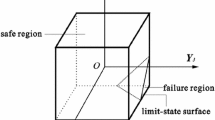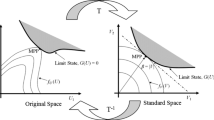Abstract
For practical engineering design problems, random variables tend to follow multimodal probability distributions when working at multiple operating conditions. For example, the structural fatigue stress of a steel bridge carrying both highway and railway traffic obeys the bimodal distribution. The existing popular reliability-based design optimization (RBDO) methods are mainly used to treat random variables with only unimodal distributions, which, therefore, tends to result in relatively large computational errors when multimodal random variables are involved. In this paper, a sequential approximate RBDO method is firstly proposed for engineering design involving multimodal random variables. The probability density function (PDF) of the response function is firstly calculated to assess the reliability of each probabilistic constraint, due to the existence of multimodal random variables. Then, a deterministic optimization problem is established to calculate candidate design points, based on the approximation that the response PDF demonstrates only transitional deformation in the optimization process. Three numerical examples and one engineering application of a thermal laptop design are presented to demonstrate the effectiveness of the proposed method.

















Similar content being viewed by others
References
Cheng G, Xu L, Jiang L (2006) A sequential approximate programming strategy for reliability-based structural optimization. Comput Struct 84:1353–1367
Cho TM, Lee BC (2011) Reliability-based design optimization using convex linearization and sequential optimization and reliability assessment method. Struct Saf 33:42–50
Du X, Chen W (2004) Sequential optimization and reliability assessment method for efficient probabilistic design. J Mech Des 126:225–233
Du X, Guo J, Beeram H (2008) Sequential optimization and reliability assessment method for multidisciplinary systems design. Struct Multidiscip Optim 35(2):117–130
Dubourg V, Sudret B, Bourinet J (2011) Reliability-based design optimization using kriging surrogates and subset simulation. Struct Multidiscip Optim 44(5):673–690
Enevoldsen I, Sørensen JD (1994) Reliability-based optimization in structural engineering. Struct Saf 15(3):169–196
Figueiredo MAT, Jian AK (2002) Unsupervised learning of finite mixture models. IEEE Trans Pattern Anal Mach Intell 24(3):381–396
Goswami S, Chakraborty S, Chowdhury R, Rabczuk T (2019) Threshold shift method for reliability-based design optimization. Struct Multidiscip Optim 60:2053–2072
Haider SW, Harichandran RS, Dwaikat MB (2009) Closed-form solutions for bimodal axle load spectra and relative pavement damage estimation. J Transp Eng 135(12):974–983
He J, Guan X, Jha R (2016) Improve the accuracy of asymptotic approximation in reliability problems involving multimodal distributions. IEEE Trans Reliab 65(4):1724–1736
Hu Z, Du X (2017) A mean value reliability method for bimodal distributions, in: Proceedings of the ASME 2017 International Design Engineering Technical Conference & Computers and information in engineering conference, Paper DETC 2017–67279
Huang ZL, Jiang C, Zhou YS, Luo Z, Zhang Z (2016) An incremental shifting vector approach for reliability-based design optimization. Struct Multidiscip Optim 53(3):523–543
Huang ZL, Jiang C, Zhang Z, Zhang W, Yang TG (2019) Evidence-theory-based reliability design optimization with parametric correlations. Struct Multidiscip Optim 60:565–580
Keshtegar B, Hao P (2018) Enhanced single-loop method for efficient reliability-based design optimization with complex constraints. Struct Multidiscip Optim 57:1731–1747
Keshtegar B, Lee I (2016) Relaxed performance measure approach for reliability-based design optimization. Struct Multidiscip Optim 54(6):1439–1454
Liang J, Mourelatos ZP, Tu J (2004) A single-loop method for reliability-based design optimization, in: Proceedings of the ASME Design Engineering Technical Conferences and Computers and Information in Engineering Conference, pp DETC 2004–57255
Lima RS, Kucuk A, Berndt CC (2002) Bimodal distribution of mechanical properties on plasma sprayed nanostructured partially stabilized zirconia. Mater Sci Eng A 327(2):224–232
Liu W, Belytschko T, Mani A (1986) Random field finite elements. Int J Numer Methods Eng 23(10):1831–1845
Moens E, Araújo NA, Vicsek T, Herrmann HJ (2014) Shock waves on complex networks. Sci Rep 4:4949
Ni YQ, Ye XW, Ko JM (2010) Monitoring-based fatigue reliability assessment of steel bridges: analytical model and application. J Struct Eng 136(12):1563–1573
Ni YQ, Ye XW, Ko JM (2011) Modeling of stress spectrum using long-term monitoring data and finite mixture distributions. J Eng Mech 138(2):175–183
Nikou C, Galatsanos NP (2007) A class-adaptive spatially variant mixture model for image segmentation. IEEE Trans Image Process 16(4):1121–1130
Papadrakakis M, Lagaros ND (2002) Reliability-based structural optimization using neural networks and Monte Carlo simulation. Comput Methods Appl Mech Eng 191(32):3491–3507
Papadrakakis M, Stefanou G, Papadopoulos V (2010) Computational methods in stochastic dynamics. Springer, Berlin
Reddy MV, Granhdi RV, Hopkins DA (1994) Reliability based structural optimization: a simplified safety index approach. Comput Struct 53(6):1407–1418
Schuöllera GI, Jensen HA (2008) Computational methods in optimization considering uncertainties-an overview. Comput Methods Appl Mech Eng 198(1):2–13
Shan S, Wang G (2008) Reliable design space and complete single-loop reliability-based design optimization. Reliab Eng Syst Saf 93(8):1218–1230
Sobczyk K, Trcebicki J (1999) Approximate probability distributions for stochastic systems: maximum entropy method. Comput Methods Appl Mech Eng 168(168):91–111
Timm DH, Tisdale SM, Turochy RE (2005) Axle load spectra characterization by mixed distribution modelling. J Transp Eng 131(2):83–88
Tu J, Choi KK, Park YH (1999) A new study on reliability-based design optimization. J Mech Des 121(4):557–564
Yi P, Cheng G, Jiang L (2008) A sequential approximate programming strategy for performance-measure-based probabilistic structural design optimization. Struct Saf 30:91–109
Youn BD, Choi KK (2004) A new response surface methodology for reliability-based design optimization. Comput Struct 82(2–3):241–256
Youn BD, Choi KK, Du L (2005) Enriched performance measure approach for reliability-based design optimization. AIAA J 43(4):874–884
Yu X, Chang KH, Choi KK (1998) Probabilistic structural durability prediction. AIAA J 36(4):628–637
Zhang X, Pandey MD (2013) Structural reliability analysis based on the concepts of entropy, fractional moment and dimensional reduction method. Struct Saf 43:28–40
Zhang X, Pandey MD, Zhang Y (2014) Computationally efficient reliability analysis of mechanisms based on a multiplicative dimensional reduction method. J Mech Des 136(6):061006–061006-11
Zhang Z, Jiang C, Han X, Ruan XX (2019) A high-precision probabilistic uncertainty propagation method for problems involving multimodal distributions. Mech Syst Signal Process 126(1):21–41
Funding
This work is supported by the National Natural Science Foundation of China (Grant No. 51805157, Grant No. 51725502 and Grant No. 51490662) and Hunan Natural Science Foundation (Grant No. 2019JJ40015).
Author information
Authors and Affiliations
Corresponding author
Ethics declarations
Conflict of interest
The authors declare that they have no conflict of interest.
Replication of results
In order to facilitate the replication of results presented in this paper, the MATLAB code files of the steel column design in Sect. 4.1 are provided as the supplementary material, and brief descriptions are given to the function of each file, as shown in Table 14. The results of the other examples can be reproduced conveniently, by modifying the characteristics of the problems such as objective function, probabilistic constraints, distribution type, dimensionality, etc
Thirteen Matlab code files are provided to perform the proposed sequential approximate method and double-loop method effectively. “MainProgram.m” is the main program of the proposed method, which consists of eight subprograms, namely, “GaussQuad.m”, “HermitePoly.m”, “UnivarQuad.m”, “GMFun.m”, “ReliabAsm.m”, “PdfFun.m”, “GNonlinear.m”, “ObjFun.m”. “DoubleLoop.m” is the main program of the double-loop method, which consists of one subprogram, namely “DLNonlinear.m”. “GMM_result.mat” is used in the programs of both methods to define the GMM characteristics and “MaxEnt_Newton” is the tool box to calculate the response PDF. The function of each subprogram is illustrated in Table 14.
Additional information
Responsible Editor: Byeng D Youn
Publisher’s Note
Springer Nature remains neutral with regard to jurisdictional claims in published maps and institutional affiliations.
Rights and permissions
About this article
Cite this article
Zhang, Z., Deng, W. & Jiang, C. Sequential approximate reliability-based design optimization for structures with multimodal random variables. Struct Multidisc Optim 62, 511–528 (2020). https://doi.org/10.1007/s00158-020-02507-5
Received:
Revised:
Accepted:
Published:
Issue Date:
DOI: https://doi.org/10.1007/s00158-020-02507-5




